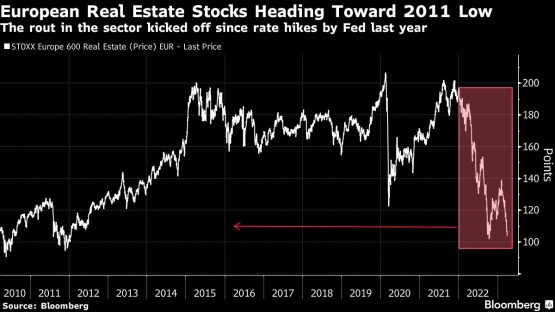Everything is looking down for Europe’s worst-hit sector: Real estate.
Facing a double whammy of rising funding costs and a predicted economic slowdown, these highly-leveraged stocks are now seen as the most vulnerable corner of European stock markets. Analysts at JPMorgan Chase & Co. issued a fresh warning on real estate, saying a potential further rise in yields poses a “major headwind,” following Citigroup Inc.’s call that the sector could halve in value.
This drumbeat of bleak assessments is happening even as the sector has already sustained major losses in recent months. Stoxx 600 Real Estate Index — which tracks around 30 shares — has nursed a decline of more than 40% over the past year, wiping out over 100 billion euros ($108 billion) in market value. From a valuation perspective, Europe’s real estate equities are trading around levels last seen during the global financial crisis.
The industry is debt-laden largely due to its reliance on mortgages, meaning that central banks’ decision to lift interest rates in order to fight inflation has pushed up servicing costs and spurred funding concerns. Globally, almost $175 billion of real estate credit is already considered “distressed,” Bloomberg reported earlier this year.
“In Europe, investors have not perceived real estate as an inflation hedge and have focused on companies which are the most leveraged,” said Lilia Peytavin, European portfolio strategist at Goldman Sachs Group Inc. “The market’s attention has crystallised on the risk of higher capital costs on companies with vulnerable balance sheets.”
The sector is Europe’s “most disliked,” according to Bank of America’s March fund manager survey, which found that about 45% of survey respondents had gone underweight on real estate, more than double the levels in February. That’s also reflected in high short interest across the board.

Commercial stress
Amid a rising risk of recession and tightening credit markets, analysts expect an immediate hit to earnings growth, with commercial real estate seen as a major pain point. Commercial mortgage-backed indexes — and especially lower-quality ones — are showing steep declines.
Recent stress in the banking sector has fueled legitimate concerns about spillover effects into the commercial real estate industry, Goldman Sachs analysts Vinay Viswanathan and Lotfi Karoui wrote in a note.
“The sector continues to face a confluence of post-pandemic headwinds, including declining occupancy rates, falling appraisal values, and more recently rising defaults,” they wrote. “Coupled with higher funding costs, elevated funding needs, and tighter lending standards, this implies a challenging fundamental backdrop in upcoming months.”

German real estate firm Aroundtown SA, which invests in commercial as well as residential real estate, is already this year’s worst European equity performer after Credit Suisse AG, having shed more than half its value since mid-January.
Property firms are also confronting a drop in demand as surging interest rates curtail mortgage applications, and in turn, asset values. The threat of a recession, moreover, could also hinder rental income.
Real estate’s downward spiral started after the Federal Reserve kicked off its rate-hiking cycle a year ago. Since then, the sectoral index’s members have spent around 25% of their operating cash flows on debt interest, Peter Garnry, head of equity strategy at Saxo Bank AS, estimated in emailed comments.

Aroundtown, for instance, gave guidance for 2023 that missed estimates, and on Wednesday it announced the suspension of its dividend payments.
Corporate bond markets are also starting to flash amber. Real estate is the only sector to have lost money in the euro high-grade corporate bond market this month, falling 2.6%. In the junk debt space, the sector has the highest two-year probability of default at 4.8%.
First Sweden, now others
A steep rout in Swedish real estate stocks early last year was in many ways the beginning of this profound crisis. Sweden’s commercial real estate sector has long been seen as a leading indicator of potential trouble, as companies have amassed billions of euros worth of floating-rate debt in the past decade.
Now, German stocks are the new laggards. Aroundtown’s 75% slump over the last year beat the losses faced by SBB AB, which has become the poster child of the Swedish real estate crisis.
While the real estate sector is typically levered, debt proportion as a percentage of enterprise value has soared in the past year, reaching about 60%, the highest since 2009. With rates now at 3.5% in the euro-area — compared to less than 0.5% for most of the past decade — refinancing debt could become more costly.

Still, some market watchers like Stephane Deo, chief market strategist at Ostrum Asset Management, say that current debt levels and the unfolding crisis are not as alarming as the global financial crisis of 2008.
“I’m not overly-worried for the sector as a whole,” said Deo by phone. “We are in the eye of the storm, where rents have not gone up yet but interest rates have.”
“With rising interest rates, prices are bound to tick down,” Ostrum’s Deo said. “But this is just an adjustment, not a real estate crash like in 2009.”
While rising financing costs and inflation have slowed down real estate in Germany in the second half of last year, property prices overall still rose by more than five percent in 2022, according to data provided by the Association of German Pfandbrief Banks.
Thomas Neuhold, head of real estate research for Kepler Cheuvreux, said stable prices and low vacancy rates are the silver-lining in Germany.
“Even highly leveraged companies still have several years to adapt their business models and reduce debt if interest rates do not unexpectedly continue to rise throughout the year,” said Neuhold, adding that German firms have some of the highest debt ratios within the sector.
© 2023 Bloomberg

